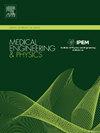Whole-cycle and time-specific validation of a GUI-based ground reaction force estimation tool for clinical gait analysis without a force plate
IF 2.3
4区 医学
Q3 ENGINEERING, BIOMEDICAL
引用次数: 0
Abstract
Relying on patients to make clean contacts with multiple force plates during clinical gait analysis can be time-consuming and dissuade clinicians from collecting biomechanical data. Several methods have been proposed to estimate ground reaction forces (GRFs) without force plates, though many can be computationally intensive. As an alternative to measuring GRFs, we evaluated the whole cycle and time frame accuracy of a built-in, GUI-based GRF estimation tool.
Twenty-seven healthy adult participants walked over two consecutive force plates. We evaluated the accuracy of estimated GRFs against force plates as the gold standard using correlation, residual error analysis, and statistical parametric mapping (SPM).
Estimated GRF magnitudes were accurate in the anterior-posterior (R2=0.86, %RMSE=7.28), and vertical directions (R2=0.86, %RMSE=6.09), but not in the medio-lateral direction (R2=0.30, %RMSE=12.46). SPM revealed errors in the sagittal plane in mid- and late-stance, with no specific errors in the medio-lateral direction.
Estimated centers of pressure (CoPs) showed good accuracy (R2≥0.99, %RMSE≤4.46). However, SPM showed estimated CoPs were consistently anterior to the true CoPs.
Sagittal GRFs are predicted with good accuracy, showing whole cycle errors comparable to more complex methods, while also displaying little early stance error and offering user-friendly implementation.
基于gui的地面反作用力估计工具的全周期和时间特异性验证,用于临床步态分析,无需力板
在临床步态分析中,依靠患者与多个力板进行清洁接触可能会耗费时间,并且会阻碍临床医生收集生物力学数据。已经提出了几种方法来估计地面反作用力(GRFs)没有力板,虽然许多可以计算密集。作为测量GRF的替代方法,我们评估了内置的基于gui的GRF估计工具的整个周期和时间框架精度。27名健康的成年参与者连续走过两个测力板。我们使用相关性、残差分析和统计参数映射(SPM)来评估估计GRFs对力板的准确性。估计的GRF大小在前后方向(R2=0.86, %RMSE=7.28)和垂直方向(R2=0.86, %RMSE=6.09)准确,但在中外侧方向(R2=0.30, %RMSE=12.46)不准确。SPM显示中位和晚位矢状面错误,中外侧方向无特异性错误。估计压力中心(cop)具有良好的准确性(R2≥0.99,%RMSE≤4.46)。然而,SPM显示估计的cop始终在真实cop的前面。矢状面GRFs的预测精度很高,显示了与更复杂的方法相当的整个周期误差,同时也显示了很少的早期姿态误差,并提供了用户友好的实现。
本文章由计算机程序翻译,如有差异,请以英文原文为准。
求助全文
约1分钟内获得全文
求助全文
来源期刊

Medical Engineering & Physics
工程技术-工程:生物医学
CiteScore
4.30
自引率
4.50%
发文量
172
审稿时长
3.0 months
期刊介绍:
Medical Engineering & Physics provides a forum for the publication of the latest developments in biomedical engineering, and reflects the essential multidisciplinary nature of the subject. The journal publishes in-depth critical reviews, scientific papers and technical notes. Our focus encompasses the application of the basic principles of physics and engineering to the development of medical devices and technology, with the ultimate aim of producing improvements in the quality of health care.Topics covered include biomechanics, biomaterials, mechanobiology, rehabilitation engineering, biomedical signal processing and medical device development. Medical Engineering & Physics aims to keep both engineers and clinicians abreast of the latest applications of technology to health care.
 求助内容:
求助内容: 应助结果提醒方式:
应助结果提醒方式:


